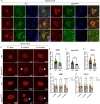NEMF mutations in mice illustrate how Importin-β specific nuclear transport defects recapitulate neurodegenerative disease hallmarks
- PMID: 39312574
- PMCID: PMC11449308
- DOI: 10.1371/journal.pgen.1011411
NEMF mutations in mice illustrate how Importin-β specific nuclear transport defects recapitulate neurodegenerative disease hallmarks
Abstract
Pathological disruption of Nucleocytoplasmic Transport (NCT), such as the mis-localization of nuclear pore complex proteins (Nups), nuclear transport receptors, Ran-GTPase, and RanGAP1, are seen in both animal models and in familial and sporadic forms of amyotrophic lateral sclerosis (ALS), frontal temporal dementia and frontal temporal lobar degeneration (FTD\FTLD), and Alzheimer's and Alzheimer's Related Dementias (AD/ADRD). However, the question of whether these alterations represent a primary cause, or a downstream consequence of disease is unclear, and what upstream factors may account for these defects are unknown. Here, we report four key findings that shed light on the upstream causal role of Importin-β-specific nuclear transport defects in disease onset. First, taking advantage of two novel mouse models of NEMF neurodegeneration (NemfR86S and NemfR487G) that recapitulate many cellular and biochemical aspects of neurodegenerative diseases, we find an Importin-β-specific nuclear import block. Second, we observe cytoplasmic mis-localization and aggregation of multiple proteins implicated in the pathogenesis of ALS/FTD and AD/ADRD, including TDP43, Importin-β, RanGap1, and Ran. These findings are further supported by a pathological interaction between Importin-β and the mutant NEMFR86S protein in cytoplasmic accumulations. Third, we identify similar transcriptional dysregulation in key genes associated with neurodegenerative disease. Lastly, we show that even transient pharmaceutical inhibition of Importin-β in both mouse and human neuronal and non-neuronal cells induces key proteinopathies and transcriptional alterations seen in our mouse models and in neurodegeneration. Our convergent results between mouse and human neuronal and non-neuronal cellular biology provide mechanistic evidence that many of the mis-localized proteins and dysregulated transcriptional events seen in multiple neurodegenerative diseases may in fact arise primarily from a primary upstream defect in Importin- β nuclear import. These findings have critical implications for investigating how sporadic forms of neurodegeneration may arise from presently unidentified genetic and environmental perturbations in Importin-β function.
Copyright: © 2024 Plessis-Belair et al. This is an open access article distributed under the terms of the Creative Commons Attribution License, which permits unrestricted use, distribution, and reproduction in any medium, provided the original author and source are credited.
Conflict of interest statement
The authors have declared that no competing interests exist.
Figures







References
MeSH terms
Substances
Grants and funding
LinkOut - more resources
Full Text Sources
Medical
Molecular Biology Databases
Miscellaneous

